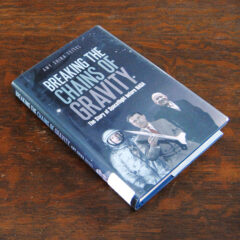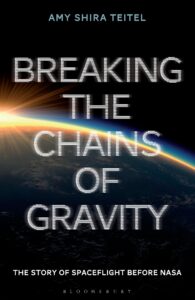
“NASA wasn’t created in a vacuum and suddenly tasked with the Moon landing,” writes Amy Shira Teitel in her debut publication Breaking the Chains of Gravity: The Story of Spaceflight before NASA.
Without historians and authors, of which Teitel is both, it would appear as if NASA did just appear on the scene ready, able, and willing to start Projects Mercury, Gemini, and Apollo. But the truth is much more intriguing and far less polished than pop culture and general history would have you believe.
Teitel covers just what is and what isn’t in Breaking the Chains by stating early on that, “The complete, unedited story would be a tome that only die-hard space fans would have the patience to sift through. Spaceflight is part of our shared human history and shouldn’t be an opus accessible only to initiates. It should be available to everyone interested in exploring this rich history.“
The author not only makes this accessible; she makes it enjoyable to read, which is something that isn’t easy considering how much technical information is necessary because it stacks onto itself. You slowly come to understand how the evolution of engineering happens throughout the course of the narrative.

Author Amy Shira Teitel
The other thing that becomes painfully apparent is the importance of NASA’s contributions to spaceflight after its creation at the end of this book. The United States’ intra-military posturing duplicated efforts and programs to such a level that, had they not been joined under one roof with one clear goal, the history of spaceflight might have been vastly different.
In fact, governmental debacles of red tape were on full display before NASA came around. Scientists and engineers, including central figures like Wernher von Braun, trudged through the rigmarole because they were both fascinated with pushing the technology forward to achieve space exploration and because they understood that it was the next step.

Reading this book not so long after mankind left footprints on the Moon and landed robots on Mars may make some of those observations about what comes next seem out of date. It is important, however, to remember that context is everything, and Teitel provides that essential context. Much like NASA, this book is not history in a vacuum. It is history with context and understanding. The politics are as important to the decision-making as the failures are to learning from mistakes.
Teitel even makes an effort to point to the context early in the book:
“Humanity’s exploration of space is wonderful. Having a deeper understanding of how it all started is not only interesting, having a sense of the context makes everything we have achieved in the last half-century of space exploration that much more incredible.”
She’s not only correct, but her book is an example of just how impressive humanity’s exploration of space is, based on the how and why of where it all started. That’s why this book, and Teitel’s other title, “Fighting for Space,” are worth your time.